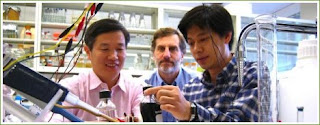One way to store that trickle is to run a chemical reaction that will leave us with some combustible fuel. For example, scientists are working on catalysts that will make it easier to split water into O2 and H2 – the latter being combustible hydrogen - using electricity derived from photovoltaic power.
In the same vein, scientists recently developed a process called electromethanogensis. If you break down the name, you see that the process involves generating methane (natural gas) from electricity. How does this happen? The answer lies in a species of bacteria known as Methanobacterium palustre (see the word “methane” in there?), which is able to chemically reduce carbon dioxide (CO2) into methane (CH4).
The bacteria is used as part of an electrolytic cell. An electrolytic cell is the opposite of a battery – a battery takes two compounds that want to react with each other and taps that potential in the form of electricity. In an electrolytic cell, the electrons are pumped in and they drive the reaction uphill, so to speak. In this case that uphill reaction is CO2 turning into CH4 (the opposite of the downhill version, which happens when we burn CH4, or any other fossil fuel). The bacteria’s job is to catalyze the process, which means that you get a lot more natural gas for the same amount of electricity fed in.
What’s interesting is that the scientist primarily involved, Dr. Bruce Logan of Penn State University, has also used bacteria for the opposite process – microbial fuel cells (in fact he wrote a book on the subject). In that process, bacteria are harnessed to eat nasty molecules from sources such as municipal waste pools, break them down and release electric energy as a byproduct.
This is the kind of thing that makes biological-based energy sources so intriguing. In reality, bio-energy makes up a tiny fraction of all renewable energy out there, and some suggest that it will always be that way. But in principle, bio-energy holds so much potential that it’s hard to say where the technology will be in 10 years from now. We’ve been tweaking microbes to make drugs and natural products for a while, but we’ve only begun thinking about incorporating them into the energy infrastructure, be it in methane synthesis such as this, bio-diesel production or algae fuel.
Provided by ecogeek.org

No comments:
Post a Comment